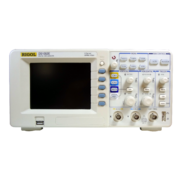Difference between revisions of "Rigol DS1000 series"
Jump to navigation
Jump to search
Uwe Hermann (talk | contribs) m (Uwe Hermann moved page Rigol DS1000 Series to Rigol DS1000 series without leaving a redirect) |
Uwe Hermann (talk | contribs) |
||
| Line 6: | Line 6: | ||
| channels = 2 analog (all models), 16 digital (D models only) | | channels = 2 analog (all models), 16 digital (D models only) | ||
| samplerate = 1GSa/s (1ch), 500MSa/s (2ch) | | samplerate = 1GSa/s (1ch), 500MSa/s (2ch) | ||
| samplerate_equiv = 10GSa/s | | samplerate_equiv = 10GSa/s or 25GSa/s (depending on model) | ||
| bandwidth = 50-150MHz (depending on model) | | bandwidth = 50-150MHz (depending on model) | ||
| vertical_resolution = 8bits | | vertical_resolution = 8bits | ||
| Line 26: | Line 26: | ||
== Devices == | == Devices == | ||
{| class=" | {| border="0" style="font-size: smaller" class="alternategrey sigroktable sortable" | ||
!Model || Bandwidth || Analog | !Model || Samplerate || Eq. samplerate || Bandwidth || Analog channels || Digital channels | ||
|- | |- | ||
|| [[Rigol DS1052E | DS1052E]] || 50MHz || 2 || None | || [[Rigol DS1052E | DS1052E]] || 1GSa/s || 10GSa/s || 50MHz || 2 || None | ||
|- | |- | ||
|| | || DS1052D || 1GSa/s || 10GSa/s || 50MHz || 2 || 16 | ||
|- | |- | ||
|| | || [[Rigol DS1102E | DS1102E]] || 1GSa/s || 25GSa/s || 100MHz || 2 || None | ||
|- | |- | ||
|| | || DS1102D || 1GSa/s || 25GSa/s || 100MHz || 2 || 16 | ||
|- | |- | ||
|| | || DS1152E-EDU || 1GSa/s || 25GSa/s || 150MHz || 2 || None | ||
|- | |- | ||
|| DS1152D || 150MHz || 2 || 16 | || DS1152D-EDU || 1GSa/s || 25GSa/s || 150MHz || 2 || 16 | ||
|} | |} | ||
== Protocol == | == Protocol == | ||
All devices in the series support both [[USBTMC]] and RS232 connections. The same SCPI protocol is used over both connections. The serial parameters are 8n1, with baud rate from 9600 to 38400 (configurable in Utility/IO Setting menu on the scope). | All devices in the series support both [[USBTMC]] and RS232 connections. The same SCPI protocol is used over both connections. The serial parameters are 8n1, with baud rate from 9600 to 38400 (configurable in '''Utility/IO Setting''' menu on the scope). | ||
== Resources == | == Resources == | ||
Latest revision as of 16:32, 14 February 2015
 | |
| Status | supported |
|---|---|
| Source code | rigol-ds |
| Channels | 2 analog (all models), 16 digital (D models only) |
| Samplerate | 1GSa/s (1ch), 500MSa/s (2ch) |
| Samplerate (eq. time) | 10GSa/s or 25GSa/s (depending on model) |
| Analog bandwidth | 50-150MHz (depending on model) |
| Vertical resolution | 8bits |
| Triggers | edge, pulse width, slope, video, pattern, continuous time, alternate |
| Input impedance | 1MΩ‖15pF 300V RMS CAT I |
| Memory | 1Mpts (mode/ch-dependent) |
| Display | 5.7" QVGA (320x240), 64K colors |
| Connectivity | USB host/device, RS232, pass/fail out |
| Features | math: + / — / x / FFT, vertical sensitivity: 2mV/div - 10V/div |
| Website | rigolna.com |
The Rigol DS1000 series are 50-150MHz, 1GSa/s, 2-channel digital storage oscilloscopes. The 'D' suffixed models also include a 16 channel logic analyzer.
The bandwidth limitations appear to be software-imposed, and devices can be "upgraded" to a model number with a higher bandwidth by changing a firmware setting using undocumented commands in the protocol.
All variants currently appear to have the same USB VID and PID (1ab1:0588).
Devices
| Model | Samplerate | Eq. samplerate | Bandwidth | Analog channels | Digital channels |
|---|---|---|---|---|---|
| DS1052E | 1GSa/s | 10GSa/s | 50MHz | 2 | None |
| DS1052D | 1GSa/s | 10GSa/s | 50MHz | 2 | 16 |
| DS1102E | 1GSa/s | 25GSa/s | 100MHz | 2 | None |
| DS1102D | 1GSa/s | 25GSa/s | 100MHz | 2 | 16 |
| DS1152E-EDU | 1GSa/s | 25GSa/s | 150MHz | 2 | None |
| DS1152D-EDU | 1GSa/s | 25GSa/s | 150MHz | 2 | 16 |
Protocol
All devices in the series support both USBTMC and RS232 connections. The same SCPI protocol is used over both connections. The serial parameters are 8n1, with baud rate from 9600 to 38400 (configurable in Utility/IO Setting menu on the scope).
Resources
- DS1000E Programming Guide (link dead)
- Rigol Homebrew wiki (lots of useful info)